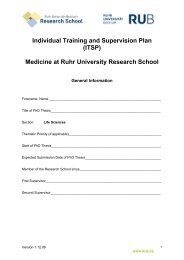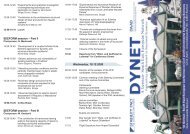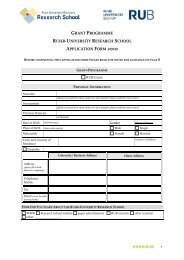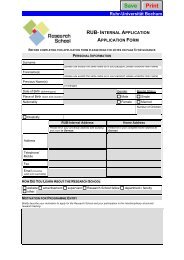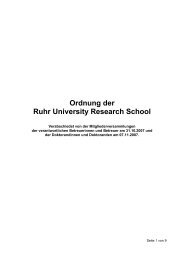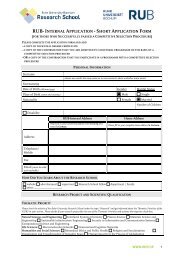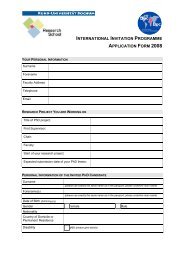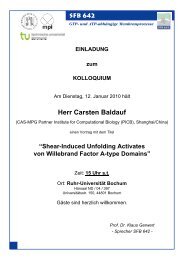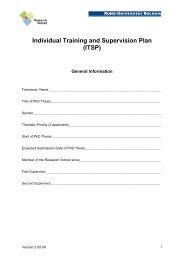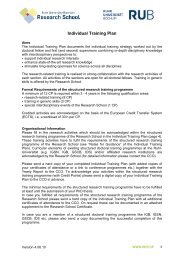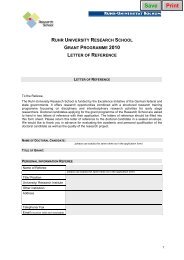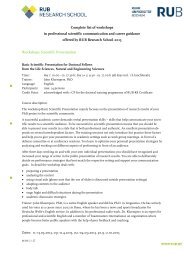Section Days abstract book 2010.indd - RUB Research School ...
Section Days abstract book 2010.indd - RUB Research School ...
Section Days abstract book 2010.indd - RUB Research School ...
Create successful ePaper yourself
Turn your PDF publications into a flip-book with our unique Google optimized e-Paper software.
PREMISES OF AID FOR TRADE<br />
Jens Königer, Matthias Busse and Georg Koopmann<br />
Lehrstuhl für Internationale Wirtschaftsbeziehungen; Ruhr-Universität Bochum, 44780<br />
Bochum, Germany<br />
e-mail: jens.koeniger@rub.de<br />
The objective of the Aid for Trade Agenda is to enable developing countries to benefit from<br />
trade liberalization. Aid for Trade (AfT) seeks to build bridges between the development and<br />
trade communities as well as between the public and private sector. It involves external or<br />
foreign assistance to developing countries in the negotiation, design, implementation and<br />
assessment of policies aimed at<br />
• helping economic actors – firms and households – in developing countries to benefit<br />
from and cope with structural change in international trade; and at<br />
• “mainstreaming” international trade into domestic economic development.<br />
The underlying principle is that trade has the potential to substantially increase economic<br />
welfare. Exploring comparative advantages of particular goods, using economies of scale in<br />
production or taking advantage of technology spillovers, all these actions are likely to boost<br />
economic growth rates. Based on various theoretical models, abundant empirical literature has<br />
examined the welfare effects of trade (volumes) on income levels and growth rates. If<br />
anything, the majority of studies show that trade is positively associated with growth rates.<br />
This view of trade fostering economic development, however, is not undisputed. It has been<br />
shown that trade does not automatically lead to economic development, but rather only if<br />
certain preconditions are fulfilled, e.g., with respect to business regulations or institutional<br />
quality.<br />
Our analysis contributes to this debate by exploring the prerequisites for a positive tradegrowth<br />
nexus. More specifically, in an empirical analysis the relevant parts of the Aid for<br />
Trade agenda will be examined with respect to their potential to boost economic growth rates<br />
through trade. More specifically, we identify variables in three different areas that are crucial<br />
for the AfT agenda: institutions, infrastructure and human capital. As resources are not<br />
unlimited, it is especially important to find out which of the different areas reveal an empirical<br />
influence of trade on economic growth. Most, if not all, of these variables clearly have a direct<br />
effect on economic development. Better institutions, better infrastructure and more human<br />
capital lead to higher economic growth. But the objective of AfT is to improve conditions in<br />
those areas which, apart from these direct effects, lead indirectly to higher economic<br />
development through the channel of trade. For example, an improvement in physical<br />
infrastructure facilitates trade, and the resulting increase in trade leads in turn to higher<br />
economic development. The crucial question in the discussion on AfT is in which areas such<br />
indirect effects can be found. To answer this research question, we constructed a<br />
comprehensive econometric model designed to explain growth differentials between<br />
countries. The empirical analysis uses a large data set, covering about 100 countries from<br />
1971 to 2005.



